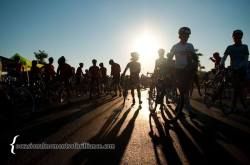Racing and training in the Midwest summer almost certainly mean being prepared to deal with heat and humidity. There are certain inherent risks to doing so, but the good news is the body can adapt to these conditions with a careful approach. Although it may still be unpleasant, it will be much more tolerable.
Essentially, there are several physiological changes that take place within the body when exposed to heat. Initially, this means increased sodium retention to help maintain plasma volume as more blood goes to the skin for cooling. As acclimatization progresses, this effect diminishes, but is compensated for through earlier onset of sweating, increased sweat rate and less sodium lost through sweat.
The time required for complete acclimatization varies among individuals. For most people, the bulk of this adaptation is complete within 10 to 14 days, although complete adaptation may take up to 2 months. The more fit a person is, the quicker he/she tends to adapt because the body is already accustomed to the thermal stress of exercise. Humid conditions also complicate this process because the cooling effect of sweat evaporation is impaired by the high moisture content in the air.
Several strategies can be employed to help foster acclimatization. Most important is to reduce workout volume or intensity during the first few weeks of more intense heat. Near the end of that 10- to 14-day period mentioned above, you can gradually begin to return to normal training volume. Steadily spending more time training in the heat will also help the process along. This does not mean you have to exercise in the hottest parts of the day, but it is necessary to gain exposure in conditions warmer than you’re accustomed to.
On the other side of the coin, there are several things you can do to help yourself manage the heat:
- Increasing fluid intake is necessary to offset increased sweat rate.
- Cool water poured over the head and neck occasionally will help to maintain body temperature.
- Wearing light-colored clothing will help to reflect sunlight so that you don’t feel as warm.
- Lightweight materials breathe better, which will allow sweat to be transferred to the surface where it can evaporate more effectively.
Employed together, these strategies will keep you free to exercise through the hottest parts of the summer and let you appreciate the cooler fall climate even more.

